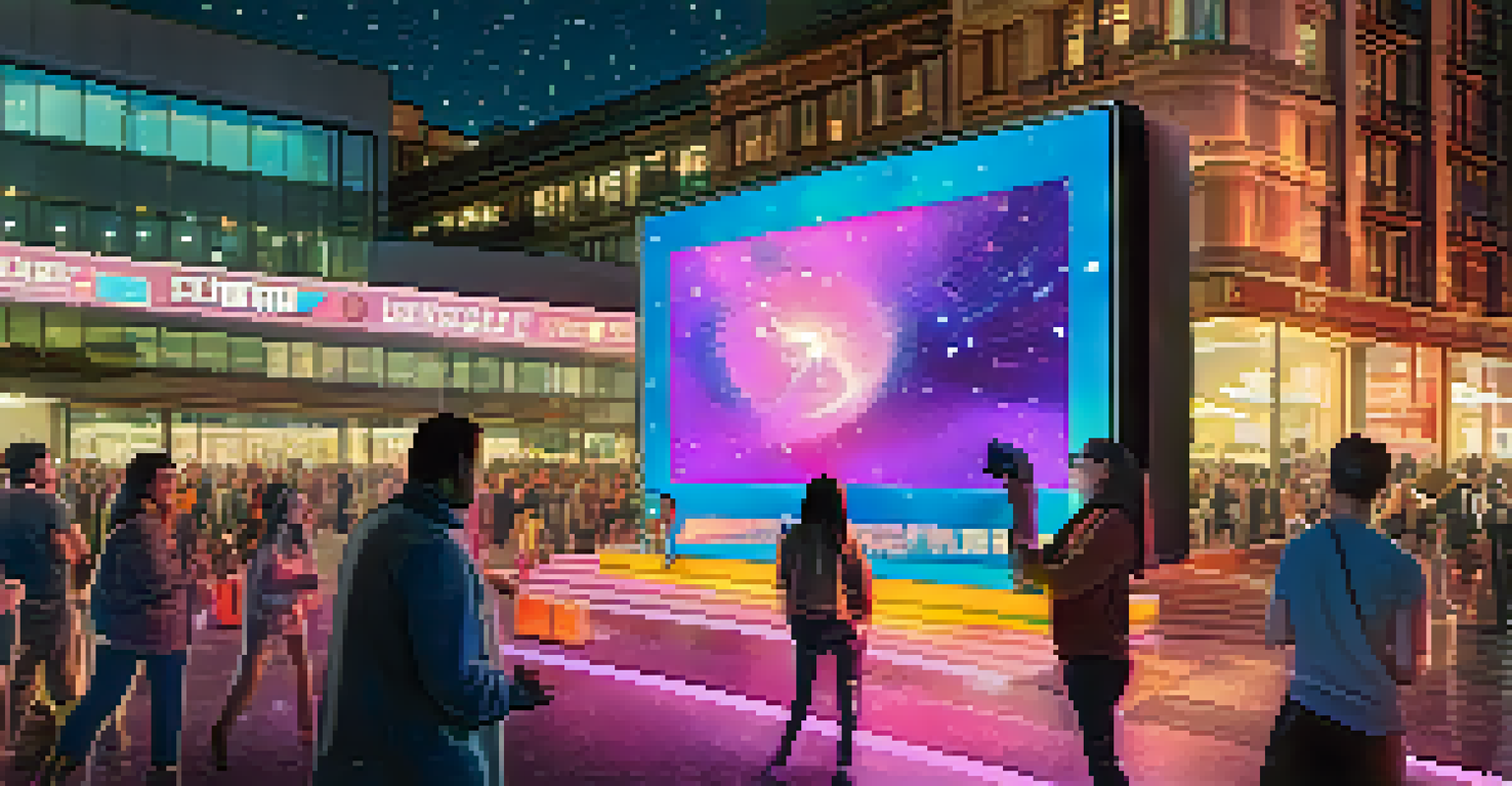The Impact of Hollywood on International Advertising Trends

Hollywood's Global Reach and Cultural Influence
Hollywood is more than just a film industry; it's a cultural powerhouse that shapes trends across the globe. Movies and television shows produced in Hollywood reach millions, creating a shared cultural language that transcends borders. This widespread exposure allows brands to tap into familiar narratives that resonate with diverse audiences, making advertisements more relatable and effective.
Hollywood is a place where they place you under contract instead of a marriage contract.
For instance, a global brand might feature a Hollywood star in their advertising campaign to leverage their popularity. This not only boosts brand recognition but also aligns the brand with the aspirational lifestyle often portrayed in films. As viewers associate the brand with the star's image, the advertisement gains an extra layer of appeal.
Moreover, Hollywood's storytelling techniques provide a blueprint for advertisers. By adopting cinematic elements like emotional storytelling and high production value, brands can create ads that captivate viewers and leave a lasting impression. This blend of entertainment and marketing is transforming how businesses connect with customers around the world.
The Rise of Influencer Marketing in Advertising
In recent years, influencer marketing has gained momentum, with celebrities from Hollywood serving as the face of numerous brands. These influencers have enormous followings on platforms like Instagram and TikTok, offering businesses a direct line to potential customers. By collaborating with these stars, brands can harness the power of their influence to reach targeted audiences effectively.

For example, a beauty brand might partner with a well-known actress to showcase their product in a relatable way. This strategy not only increases the product's visibility but also builds trust, as fans often view these celebrities as relatable figures. When a trusted influencer endorses a product, consumers are more likely to consider it in their purchasing decisions.
Hollywood Shapes Global Advertising
Hollywood's storytelling techniques and star power influence global advertising strategies, enabling brands to connect with diverse audiences.
The success of influencer marketing reflects Hollywood's ability to shape consumer behavior. As audiences become more discerning, they seek authentic connections with brands, and influencers provide that bridge. This trend shows how Hollywood's impact extends beyond entertainment and into the fabric of modern advertising strategies.
Cinematic Techniques in Advertising Campaigns
Modern advertisers are increasingly borrowing cinematic techniques to enhance their campaigns. High-quality visuals, dramatic storytelling, and emotional resonance are just a few elements that advertisers adopt from film. By creating ads that feel like short movies, brands can engage viewers on a deeper level, making them more memorable.
The greatest thing about Hollywood is that it’s a melting pot of cultures and ideas, and that’s what makes it so rich and diverse.
Consider a car commercial that tells a heartfelt story about family adventures and road trips. By framing the vehicle within a narrative, the brand evokes emotions that viewers can relate to personally. This approach not only showcases the product but also creates a connection that drives consumer loyalty.
Additionally, the use of music and sound design, akin to film scores, can elevate the overall impact of an advertisement. A well-chosen soundtrack can evoke feelings and set the tone, making the message resonate long after the ad is over. This blending of advertising and cinematic artistry highlights Hollywood's profound influence on marketing trends.
Globalization of Advertising Through Hollywood
Hollywood's influence has also catalyzed the globalization of advertising. As films and series are distributed worldwide, brands recognize the opportunity to create campaigns that appeal to international audiences. This trend has led to the emergence of global advertising strategies that leverage Hollywood's storytelling prowess.
For instance, a fast-food chain might launch a campaign featuring international celebrities that resonate with local cultures while maintaining a universal theme. This approach allows brands to remain relevant in different markets while capitalizing on Hollywood's star power. It’s a delicate balance of local relevance and global appeal.
Diversity Drives Modern Campaigns
The push for diversity and representation in both Hollywood and advertising encourages brands to reflect societal values and foster deeper connections with consumers.
As brands adopt this global mindset, they often find that their advertising campaigns can transcend cultural barriers. By using familiar Hollywood icons and narratives, they create a sense of belonging and shared experience among diverse consumer groups. This trend underscores Hollywood's role in shaping not just advertising but global culture as a whole.
The Impact of Diversity and Representation in Ads
Diversity and representation have become crucial elements in both Hollywood and advertising. As audiences become more aware of social issues, they expect brands to reflect the diversity of society in their campaigns. Hollywood has led the charge by showcasing a broader range of voices and stories, influencing how brands approach representation.
For example, a clothing brand might cast models from various backgrounds, showcasing different body types, ethnicities, and lifestyles. This not only promotes inclusivity but also aligns the brand with contemporary values, making it more appealing to socially conscious consumers. By mirroring Hollywood's progress toward diversity, brands can foster a deeper connection with their audience.
Moreover, advertisements that prioritize representation are often met with positive consumer feedback. When audiences see themselves reflected in ads, it creates a sense of validation and belonging. This shift in advertising strategy, inspired by Hollywood's evolving landscape, demonstrates the industry's commitment to inclusivity and social responsibility.
The Role of Humor and Satire in Advertising
Humor has long been a staple of Hollywood films, and its influence is evident in modern advertising campaigns. Many brands are now using humor and satire to capture attention and convey their messages in a memorable way. This strategy not only entertains but also creates a positive association with the brand.
For instance, a beer company might produce a commercial filled with comedic skits that reflect relatable social scenarios. By making viewers laugh, the brand increases the likelihood of being remembered when consumers are making purchasing decisions. Humor can break down barriers and foster a sense of camaraderie between brands and their audience.
Humor Enhances Brand Recall
Using humor and satire in advertising, inspired by Hollywood, helps brands engage audiences and create positive associations with their products.
However, brands must tread carefully when using humor, as it can be subjective. What might be funny to one demographic could be off-putting to another. By studying successful comedic elements from Hollywood, brands can tailor their approach to resonate with their target audience while still being entertaining.
The Future of Advertising: Trends Influenced by Hollywood
As we look to the future, it's clear that Hollywood will continue to shape advertising trends. The rise of streaming platforms and digital content creates new opportunities for brands to engage consumers. Advertisers are now exploring innovative formats, such as interactive ads and branded content, inspired by the storytelling techniques used in films and series.
Another trend is the increasing use of virtual reality (VR) and augmented reality (AR), which can create immersive advertising experiences. Imagine stepping into a virtual world where you can interact with a brand's products just like characters in a movie. This blending of technology and storytelling will redefine how brands connect with consumers, drawing heavily from Hollywood's creative expertise.

Ultimately, as the lines between entertainment and advertising continue to blur, brands will need to stay agile and adapt to changing consumer preferences. Hollywood's influence will remain pivotal in guiding these trends, encouraging brands to think creatively and embrace new storytelling methods to captivate audiences worldwide.